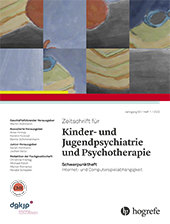Klassifikation von Aufmerksamkeitsdefizit-/Hyperaktivitätsstörungen in der ICD-11
Abstract
Zusammenfassung. Der Beitrag gibt eine kurze Übersicht über die Veränderungen in der Klassifikation von Hyperkinetischen Störungen und Aufmerksamkeitsdefizit-/Hyperaktivitätsstörungen nach ICD-11 (International Statistical Classification of Diseases and Related Health Problems). Sowohl in der Bezeichnung als auch in der Binnendifferenzierung lehnt sich ICD-11 erfreulicherweise an das DSM-5 (Diagnostic and Statistical Manual of Mental Disorders) an. Auch die Aufgabe der ICD-10-Kombinationsdiagnose der Hyperkinetischen Störung des Sozialverhaltens zugunsten von Mehrfachdiagnosen ist zu begrüßen. Der Verzicht auf eine exakte Operationalisierung der Kriterien hilft einerseits bei der Einordung von Grenzfällen in der klinischen Praxis, macht es aber auch notwendig, für die Klärung der einzelnen Symptome auf das DSM-5 zurückzugreifen.
Abstract. The article gives a brief overview of the modifications to the classification of hyperkinetic disorders/attention deficit/hyperactivity disorders according to ICD-11. Fortunately, these modifications are based on DSM-5, both in terms of their designation and the internal differentiation of the diagnosis. That the ICD-10 relinquishes the combination diagnosis of hyperkinetic conduct disorder in favor of multiple diagnoses is also to be welcomed. On the one hand, the renunciation of an exact operationalization of the symptom criteria may help with the classification of borderline cases in clinical practice; on the other hand, it also makes it necessary to resort to the DSM-5 for the clarification of the individual symptoms of the disorder.
Literatur
(2017). Aufmerksamkeitsdefizit-/ Hyperaktivierungsstörung. Deutsches Ärzteblatt, 114, 149–159.
. (2008). How often do children meet ICD-10/DSM-IV criteria of attention deficit-/hyperactivity disorder and hyperkinetic disorder? Parent based prevalence rates in a national sample – results of the BELLA study. European Child & Adolescent Psychiatry, 17(suppl 1), 59–70.
(2017). Diagnostik-System für psychische Störungen nach ICD-10 und DSM-5 für Kinder- und Jugendliche (DISYPS-III). Bern: Hogrefe.
. (2015). Long-term course of ADHD symptoms from childhood to early adulthood in a community sample. European Child & Adolescent Psychiatry, 24, 665–673.
). (2015). Diagnostisches und Statistisches Manual Psychischer Störungen, DSM-5®. Göttingen: Hogrefe.
(2021). Auf dem Weg zur ICD-11. Zeitschrift für Kinder- und Jugendpsychiatrie und Psychotherapie, 49, 413–415.
(2009). Prevalence and correlates of adult attention-deficit hyperactivity disorder: Meta-analysis. British Journal of Psychiatry, 20, 204–211.



